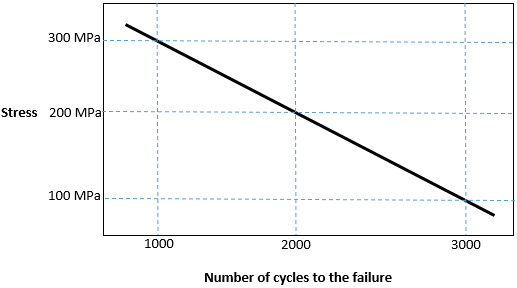This set of Mechanical Metallurgy Question Paper focuses on “Fatigue of Metals – Cumulative Fatigue Damage & Sequence Effects – 3”.
1. The electroplating always has a positive effect on fatigue properties.
a) True
b) False
View Answer
Explanation: It is generally observed the electroplating reduces the fatigue strength of the material; this is because it is associated with residual stress, porosity, etc. which lowers the fatigue strength.
2. The fatigue failure of the material is cumulative property.
a) True
b) False
View Answer
Explanation: The fatigue failure of the content depends upon the number cycle it runs, so the total number of cycle will add up, and failure becomes the cumulative property.
3. The Minor’s rule is used to calculate the ____________
a) cumulative fatigue life
b) endurance limit
c) number of cycles to failure
d) stress ratio
View Answer
Explanation: The life of component depends upon the number of the cycle at a given stress level. This is a cumulative quantity which can add up together and given by minor’s rule.
4. The minor’s rule states that ____________ where n1, n2 is the number of cycle at the given stress level and N1, N2 are total number of cycle to failure at the given stress level.
a) n1/N1+n2/N2+n3/N3+………………..+nk/Nk=1
b) N1+N2+N3+………………..+Nk=1
c) n1+n2+n3+………………..+nk=1
d) n1/N1+n2/N2+n3/N3+………………..+nk/Nk=0
View Answer
Explanation: This rule states that the life of the component is predefined for a given value of stress and if the element is stressed at different level of stress for different cycle, the net result can be added to find the total life.
5. A steel component was loaded at 300MPa for 500 cycles, then at 200 MPa it is run for 100 Cycle and rest of the life it is loaded 100 MPa. Find the total number of cycles the component has run before failing?

a) 1000
b) 750
c) 1350
d) 1500
View Answer
Explanation: Here,
-> Number cycles to failure at 300 MPa = 1000
-> Number of cycles run at 300 MPa = 500
-> Number cycles to failure at 200 MPa = 2000
-> Number of cycles run at 200 MPa = 100
-> Number cycles to failure at 100 MPa = 3000
-> Number of cycles run at 100 MPa =?
According to minor’s rule:
n1/N1+n2/N2+n3/N3+………………..+nk/Nk=1
-> 500/1000+100/2000+x/3000=1
-> 1/2+1/20+X/3000=1
-> 1-(11/20)*3000=x
-> (9/20)*3000=x
-> 9*150=x
-> x=1350.
6. The infrequent tensile stress ____________ the fatigue life, whereas the infrequent compressive load ____________ fatigue life.
a) increases, increases
b) Increases, decreases
c) decrease, increases
d) decreases, decreases
View Answer
Explanation: The infrequent tensile stress on the crack tip on unloading produces the compressive residual stress on the crack tip, so it enhances the fatigue strength. Similarly, the compressive stress produces the tensile residual stress which reduces fatigue life.
7. The fatigue limit of the cast and wrought iron is around ___________ of tensile strength.
a) 50%
b) 90%
c) 10%
d) 1%
View Answer
Explanation: The fatigue limit or the endurance limit of wrought and cast iron is around 50% of the tensile strength of the material.
8. The ratio of fatigue limit to tensile limit is called _________
a) notch sensitivity factor
b) fatigue strength reduction factor
c) fatigue ratio
d) stress concentration factor
View Answer
Explanation: The fatigue ratio is defined as the ratio of fatigue limit to the tensile strength of the material. Several non-ferrous materials have fatigue ratio around 0.35.
9. What will be the fatigue ratio of a notched specimen to an un-notched sample?
a) The un-notched sample will have higher fatigue ratio
b) The notched specimen will have higher fatigue ratio
c) Both will have the same fatigue ratio
d) Cannot comment
View Answer
Explanation: The notched specimen will have lower fatigue strength, and the un-notched sample will have higher fatigue strength so that the fatigue ratio will be higher for the un-notched sample compared to the notched specimen.
10. Which of the following microstructure of steel will have the lowest fatigue strength?
a) Pearlite
b) Globular
c) Nodular
d) Acicular
View Answer
Explanation: The pearlite has high yield strength, but the alternate layer of cementite and ferrite produce a higher notch effect in the matrix, and the fatigue strength reduces significantly.
Sanfoundry Global Education & Learning Series – Mechanical Metallurgy.
To practice all questions papers on Mechanical Metallurgy, here is complete set of 1000+ Multiple Choice Questions and Answers.
If you find a mistake in question / option / answer, kindly take a screenshot and email to [email protected]
- Practice Metallurgical Engineering MCQs
- Apply for Metallurgical Engineering Internship
- Check Mechanical Metallurgy Books
- Check Metallurgical Engineering Books
